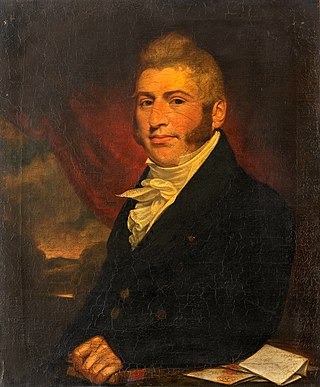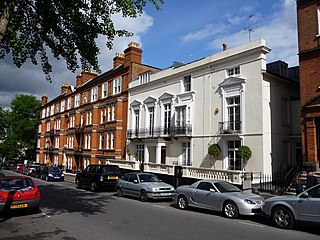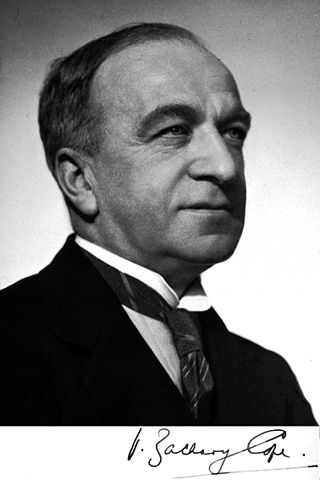
Elizabeth Garrett Anderson was an English physician and suffragist. She is known for being the first woman to qualify in Britain as a physician and surgeon and as a co-founder and dean of the London School of Medicine for Women, which was the first medical school in Britain to train women as doctors. She was the first female dean of a British medical school, the first woman in Britain to be elected to a school board and, as mayor of Aldeburgh, the first female mayor in Britain.

John Abercrombie was a Scottish physician, author, philosopher and philanthropist. His Edinburgh practice became one of the most successful medical practices in Scotland. The Chambers Biographical Dictionary says of him that after James Gregory's death, he was "recognized as the first consulting physician in Scotland". As surgeon to The Royal Public Dispensary and the New Town Dispensary he provided free medical care for the poor of the town and taught medical students and apprentices. He published extensively on medical topics and latterly on metaphysics morality and religion. A devout Christian, he gave financial support to missionary work. Abercrombie was awarded the honorary degree of MD from the University of Oxford, was elected Rector of Marischal College and University, Aberdeen and appointed Physician to the King in Scotland.

Hampstead is an area in London, England, which lies four miles northwest of Charing Cross, and extends from the A5 road to Hampstead Heath, a large, hilly expanse of parkland. The area forms the northwest part of the London Borough of Camden, a borough in Inner London which for the purposes of the London Plan is designated as part of Central London.

The Worshipful Society of Apothecaries of London is one of the livery companies of the City of London. It is one of the largest livery companies and ranks 58th in their order of precedence.

Hampstead was a civil parish and metropolitan borough in London, England. It was an ancient parish in the county of Middlesex, governed by an administrative vestry. The parish was included in the area of responsibility of the Metropolitan Board of Works in 1855 and became part of the County of London in 1889. The parish of Hampstead became a metropolitan borough in 1900, following the London Government Act 1899, with the parish vestry replaced by a borough council. In 1965 the borough was abolished and its former area became part of the London Borough of Camden in Greater London.

The Royal Free Hospital is a major teaching hospital in the Hampstead area of the London Borough of Camden. The hospital is part of the Royal Free London NHS Foundation Trust, which also runs services at Barnet Hospital, Chase Farm Hospital and a number of other sites. The trust is a founder member of the UCLPartners academic health science centre.

Belsize Park is an affluent residential area of Hampstead in the London Borough of Camden, England.

Manchester Royal Infirmary (MRI) is a large NHS teaching hospital in Chorlton-on-Medlock, Manchester, England. Founded by Charles White in 1752 as part of the voluntary hospital movement of the 18th century, it is now a major regional and national medical centre. It is the largest hospital within Manchester University NHS Foundation Trust, and based on its Oxford Road Campus in South Manchester where it shares a site with the Royal Manchester Children's Hospital, Manchester Royal Eye Hospital and Saint Mary's Hospital as well as several other educational and research facilities. The Hospital is also a key site for medical educational within Manchester, serving as a main teaching hospital for School of Medical Sciences, University of Manchester.

The Elizabeth Garrett Anderson and Obstetric Hospital and its predecessor organisations provided health care to women in central London from the mid-Victorian era. It was named after Elizabeth Garrett Anderson, one of Britain's first female physicians, and its work continues in the modern Elizabeth Garrett Anderson wing of University College Hospital, part of UCLH NHS Foundation Trust.

NHS Grampian is an NHS board which forms one of the fourteen regional health boards of NHS Scotland. It is responsible for proving health and social care services to a population of over 500,000 people living in Aberdeen, Aberdeenshire and Moray.
Edward Collis Berdoe was an English physician, anti-vivisectionist and writer. He studied and wrote on the works of Robert Browning. He also campaigned against medical experiments on human patients and animals.

Tufts Medical Center, a 15-building campus located in Boston, Massachusetts, is a downtown Boston hospital midway between Chinatown and the Boston Theater District.

Sir Vincent Zachary Cope MD MS FRCS was an English physician, surgeon, author, historian and poet perhaps best known for authoring the book Cope's Early Diagnosis of the Acute Abdomen from 1921 until 1971. The work remains a respected and standard text of general surgery, and new editions continue being published by editors long after his death, the most recent one being the 22nd edition, published in 2010. Cope also wrote widely on the history of medicine and of public dispensaries.
William Blair was an English surgeon with an interest in ciphers and stenography. He was known also for contributing articles to Rees's Cyclopædia.

Prof William Pirrie FRSE LLD was a 19th-century Scottish surgeon and medical author. He served as President of the North of Scotland Medical Association.

Alnwick Infirmary is a community hospital in Alnwick, Northumberland, England. It is managed by Northumbria Healthcare NHS Foundation Trust.
Jonathan Toogood (1784-1870) MRCS 1804, FRCS 1843, LRCP 1844 was a surgeon from the south west of England who founded the Bridgwater Infirmary in Somerset in 1813. He held strong views on many issues of the time, including the role of coroners, the Poor Law Amendment Act 1834, Homeopathy and regulations regarding the sale of arsenic.
John Henry WishartFRCSEdFRSE was a Scottish surgeon who worked at the Royal Infirmary of Edinburgh. Although a general surgeon, he developed a special interest in the diagnosis and treatment of eye disease. He translated into English three major works of the Italian anatomist and surgeon Antonio Scarpa. With John Argyll Robertson, Wishart jointly founded the Edinburgh Eye Dispensary. He was surgeon in Scotland to King George IV and served as President of the Royal College of Surgeons of Edinburgh from 1820 to 1822.
Extramural medical education in Edinburgh began over 200 years before the university medical faculty was founded in 1726 and extramural teaching continued thereafter for a further 200 years. Extramural is academic education which is conducted outside a university. In the early 16th century it was under the auspices of the Incorporation of Surgeons of Edinburgh (RCSEd) and continued after the Faculty of Medicine was established by the University of Edinburgh in 1726. Throughout the late 18th and 19th centuries the demand for extramural medical teaching increased as Edinburgh's reputation as a centre for medical education grew. Instruction was carried out by individual teachers, by groups of teachers and, by the end of the 19th century, by private medical schools in the city. Together these comprised the Edinburgh Extramural School of Medicine. From 1896 many of the schools were incorporated into the Medical School of the Royal Colleges of Edinburgh under the aegis of the RCSEd and the Royal College of Physicians of Edinburgh (RCPE) and based at Surgeons' Hall. Extramural undergraduate medical education in Edinburgh stopped in 1948 with the closure of the Royal Colleges' Medical School following the Goodenough Report which recommended that all undergraduate medical education in the UK should be carried out by universities.
Major William Wilfrid Webb (1857–1911) was an English officer and physician in the Indian Medical Service, Bengal Army. He was Superintendent of Gaols and Dispensaries for the Meywar and Bikanir States and guardian to the Maharaja of Bikanir.
















